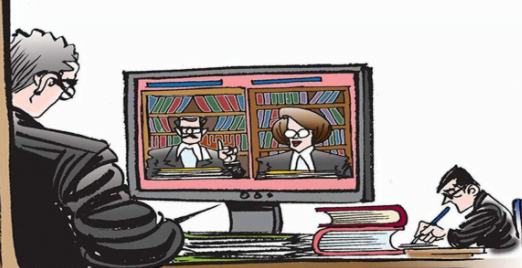Virtual Courts in India Should Stay: Panel
The Parliamentary Standing Committee on Personnel, Public Grievances, Law and Justice recommended to continue the virtual courts for some specific categories of cases even after the COVID-19 pandemic is over. The panel underlined that ‘Digital Justice’ is cheap, fast and citizen friendly. It increases the accessibility. It also addresses locational and economic challenges that public face. It has also suggested that ‘virtual proceedings’ can be extended permanently to some Appellate Tribunals that do not require appearance in person like TDSAT, IPAB and NCLAT.
What are Virtual Courts?
Virtual Courts are the e-courts or Electronic courts that aims to eliminate the presence of litigants or lawyers in the traditional court and adjudicate the cases online. These are different from the computerised courts which happens to be in place since the 1990s. The functioning requires an Online environment besides an Information and Communication Technology (ICT) enabled infrastructure.
What are the Advantages of virtual courts?
- Virtual courts Increases the efficiency.
- It results into savings in costs and also disposes off the cases on time.
- It also increases the productivity of lawyers by saving them from frequent visits to courts and long waiting hours.
- The virtual courts better utilises the manpower and infrastructure by distributing the work equally.
- It also reduces the malpractices in the judiciary.
- In the COVID-19 scenario, when physical distancing is must. The virtual courts take of this need.
Why virtual courts are need of the hour?
- Number of pending cases are very high. There are over 3.5 crore cases pending across all the courts, as of August 2019.
- Pending cases have also increased the number of under-trials in prison. In fact, it stands double than the convicts.
- Judicial Vacancies have also reduced the efficiency, accountability and has affected the functioning of the judges. Tribunals such as the Income Tax Tribunal function half-day most of the time.
- Thousands of Indians cannot afford to go to court because of high cost and complicated legal procedure.
- Physical presence leads to frequent adjournments which in turn increases the settlement time for cases.
Challenges in virtual proceeding
Though, virtual courts may seem a necessity in the present context. But It will face lot of glitches and shortcomings in its execution. Challenges include:
- The e-filling process is complicated.
- e-Courts are cost-intensive as well, in context of deployment of new-age technology.
- Hacking and cybersecurity issues.
- Insufficient infrastructure and non-availability of electricity and internet connectivity in remote villages.
- Maintaining e-courts record is another hurdle since the staffs are not well equipped and trained to effectively handle document. Thus, data can be easily accessed.
As the use of technology is stepping up, courts should also consider other steps to speed up the judicial process and reduce courtroom crowding. The other forms of justice delivery including mediation, arbitration and counselling in family court matters can be taken up online quickly. In case of virtual proceedings, though there is possibility of technical and connectivity issues affecting the process. But it has to be noted that virtual hearings are no different from open court conversations. If this practice is extended to other civil cases, efficiency of judicial functioning will drastically increase.
Case Study
The Kerala High Court conducted the proceedings and live streamed it video conferencing recently during the lockdown which created history.
Month: Current Affairs - September, 2020


